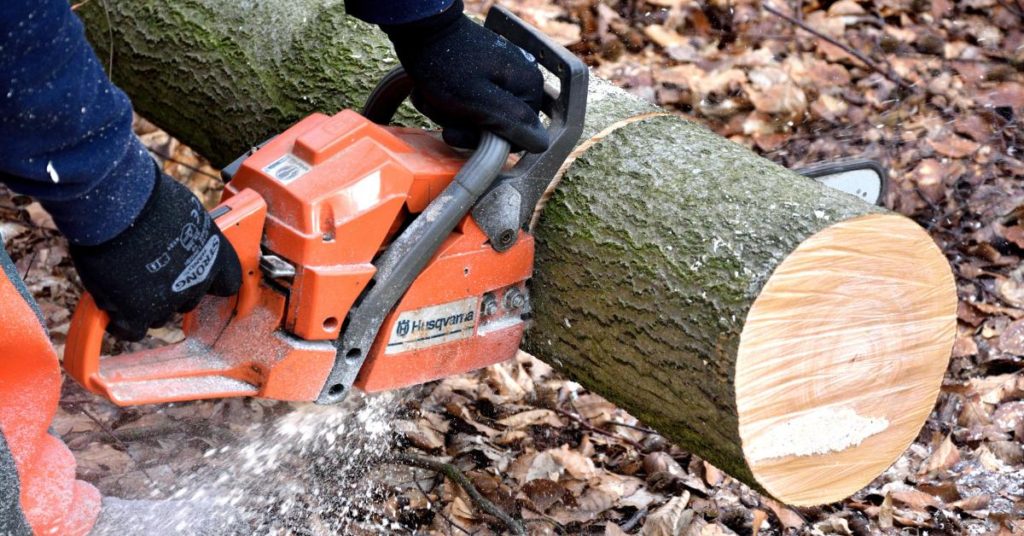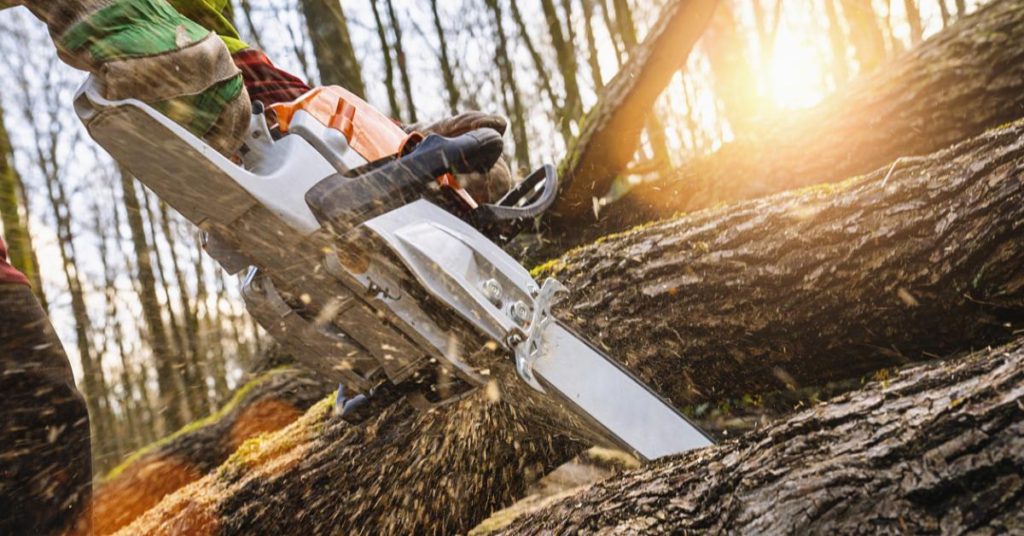Chainsaws can cause serious injury to the person using them if they are not used correctly. Chainsaws operate by rotating a blade at high speed, and all that force concentrated in one spot means you have to take extra precautions when handling this tool.
There is also kickback when operating a chainsaw; this happens when the tip of the saw binds and then suddenly jerks up or forward after encountering even slight resistance. The recoil from such an event could result in anything from a small cut to loss of fingers or hands if it catches you off-guard.
Chainsaws are therefore potentially dangerous tools. Even though chances of accidents increase with improper use, many people still get injured or killed every year because they did not follow proper guidelines for operation.
TABLE OF CONTENTS:
- What is a chainsaw used for?
- How does a chainsaw work?
- What are the hazards of using a chainsaw?
- How common are chainsaw accidents?
- How can you reduce the risk of hazards from chainsaws?
- What safety precautions are needed when using a chainsaw?
- What safety equipment is needed for chainsaws?
- What safety features do chainsaws have?
- Conclusion

What is a chainsaw used for?
A chainsaw is a type of power saw and includes many types of equipment with a common feature: they use a chain to transmit power from the motor, so the teeth of the cutting chain are actually what does the cutting.
The engine can be either gas or electric powered and cuts through wood very quickly using sharp metal teeth that grind into logs in order to cut them down or shape them.
Chainsaws are also used in emergency situations when other tools cannot get through dense material, such as clearing branches from roads after bad storms when trucks cannot pass due to fallen trees blocking their path.
In situations like these, where there is no other option, a chainsaw will do just fine.
How does a chainsaw work?
Chainsaws work by using an internal combustion engine to power the chain, which then spins several rotating cutting teeth at around 9000 rotations per minute (RPMs).
The saw’s teeth cut into whatever material they contact, and it only takes one pass to make the cut with this tool.
The operation of a typical gasoline-powered chainsaw requires: pulling start cord (manually starts the motor), choke control (mixed with gas when starting or restarting in cold weather), throttle trigger (controls speed after started), and brake handle (stops spinning blade when released).
A typical electric powered chainsaw requires:
- Power trigger (turns on the tool when pressed).
- Forward-reverse toggle switch (allows for the blade to change direction).
- Safety shield/brake lever (stops spinning blade when activated).
- Throttle trigger (controls speed of motor after it is started).

What are the hazards of using a chainsaw?
There are several hazards associated with operating a chainsaw, including:
- Kickback: this happens when the tip of the saw binds and then suddenly jerks up or forward after encountering even slight resistance. The recoil from such an event could result in anything from a small cut to loss of fingers or hands if it catches you off-guard. This is especially hazardous with curved blades because they tend to bind more easily than straight ones do.
- Flying debris: any time something is cutting through wood, there will be dust and small wood particles that will go flying
- Noise: chainsaws are loud and can damage your hearing after prolonged exposure
- Vibration: the whole tool vibrates, which is a strain on your hands and arms as well as increased fatigue. There have also been concerns about vibrations causing carpal tunnel syndrome due to the stress created by cutting effort combined with the tool’s vibrations.
Related Article: Top chainsaw tips and tricks for beginners
Another risk that arises from using a chainsaw is getting caught in the saw’s cutting area while operating it, resulting in serious injuries like limb loss.
Prevent this by wearing clothing made of coarse fibers and gloves to protect your hands when you’re working with any type of chainsaw.
How common are chainsaw accidents?
Chainsaw accidents are not common, but they can be extremely dangerous. Each year more than 7,000 people across the U.S. are treated in hospital emergency rooms for chainsaw-related injuries (some of which involve other power tools). Nearly half of all injuries occur while cutting wood.
Chainsaws are dangerous for many different reasons, but the main causes of injury involve kickback and falls. Kickback happens when something gets caught in the chainsaw or if it binds while cutting. This causes the blade to rapidly stop, which can cause the saw to jump back towards the operator at high speed.
Accidents like this can lead to serious injury (e.g., lacerations). Falls happen when an operator is overloaded with work that their saw cannot handle; they then get too tired to maintain control of their saw, causing them to fall directly on top of it.
Chainsaw accidents are preventable, so it is important to know the correct way to use a chainsaw. Always be sure that you are in good physical condition before operating one of these devices.
There are many other safety tips that are heavily emphasized when it comes to chainsaws, but there isn’t anything more important than working with your body rather than against it.
When using a chainsaw, do not rush, take your time – this sort of carelessness is what leads to most injuries and deaths associated with chainsaws.
How can you reduce the risk of hazards from chainsaws?
There are several ways you can avoid injuries when using a chainsaw, including:
- Always wear approved protective equipment such as a helmet with a face shield, appropriate footwear and gloves, ear protection, and a body harness with a shock absorber when working from an elevated position.
- Inspect the saw for damage before each use to ensure there are no cracks in the housing or any missing parts that could affect performance if they were to break.
- Using the right tool for the job: you shouldn’t try to cut metal or concrete with a chainsaw, just like you wouldn’t try cutting down trees that are wider than your saw is long. You should also not use a chainsaw to split wood unless designed for that purpose since it will be more prone to kickback when done incorrectly.
- Using the tool correctly: there are usually cutting guidelines for both gas and electric chainsaws that you should follow unless otherwise instructed by the manufacturer.
- Keeping your work area clean: don’t let anything (leaves, other debris) go into or fall onto the bar and chain while cutting to avoid build-up and any other way it might be dangerous, such as an unwanted fire source.
Using a chainsaw can be extremely dangerous if not used correctly or with all of the necessary safety precautions in place. However, accidents happen even when all of these procedures are followed.
Related Article: Which brand of chainsaw is best?
If such an accident occurs, emergency responders will likely need to remove you from your location quickly for healthcare reasons, so they may use specialized equipment to do so.
What safety precautions are needed when using a chainsaw?
There are several safety precautions you should take when working with a chainsaw:
- Use two hands: when possible, both of your hands should be used to hold onto the saw while working whenever possible. They must also always be away from the path of any moving parts or debris coming towards you.
- Avoid distractions: do not use tools like cell phones or radios if they could interfere with safe work practices.
- Wear appropriate Personal Protective Equipment (PPE): helmets, leather work gloves for chainsaws, and earplugs are the main pieces of equipment you need to use chainsaws safely
- Avoid operating a chainsaw when you’re tired or distracted
- Never cut above shoulder height
- Keep the guide bar nose down and at a 45° cutting angle
- Don’t touch the ground or standing surfaces when operating a chainsaw
- Always have someone nearby who can come to help if anything goes wrong while working with a chainsaw. If other people are near you while using a chainsaw, make sure they are familiar with how it works and know not to touch the saw while you’re operating it.
What safety equipment is needed for chainsaws?
The most important piece of personal protective equipment (PPE) that you’ll need when using a chainsaw is the right type of helmet to protect your head. If you are working in areas where there’s the possibility of falling debris, you should also wear face protection and eye protection.
- The proper footwear can help prevent foot injuries and enable better control over how the saw moves while you’re working with it, therefore reducing the risk of accidents.
- You should also make sure to wear clothing made from coarse fibers suitable for work outdoors so that it doesn’t catch on anything or fray easily if it does get caught.
- When choosing gloves, look for sturdy enough to provide protection but flexible enough for you to still feel what’s happening while operating your saw. Leather is a good option since it’s protective yet can still be maneuvered easily.
- If you’re planning on using earplugs, remember to take them out before operating the chainsaw.
What safety features do chainsaws have?
Chainsaws can be dangerous if users don’t follow proper safety guidelines. Some key safety features on most modern chain saws include:
- Chain brakes which stop the chain from moving if pressure is applied to the handguard,
- Anti-kickback devices which stop the chain from spinning if it gets caught on something while rotating,
- An emergency shut-off feature that stops all rotation of the saw whenever the user releases their grip.
Conclusion
Operating any power tool has its risks but a chainsaw can do serious damage if you dont respect it. Although there are many safety features built in to modern chainsaws, the user should always ensure that correct safety precautions are observed at all times.
Its easy to buy a chainsaw, its relatively easy to use one, but its also very easy to become complacent if you don’t keep in mind how dangerous these tools can be.
With the correct awareness of these awesome tools, you can enjoy a fun and productive time with your own chainsaw adventures!

Leave a Reply